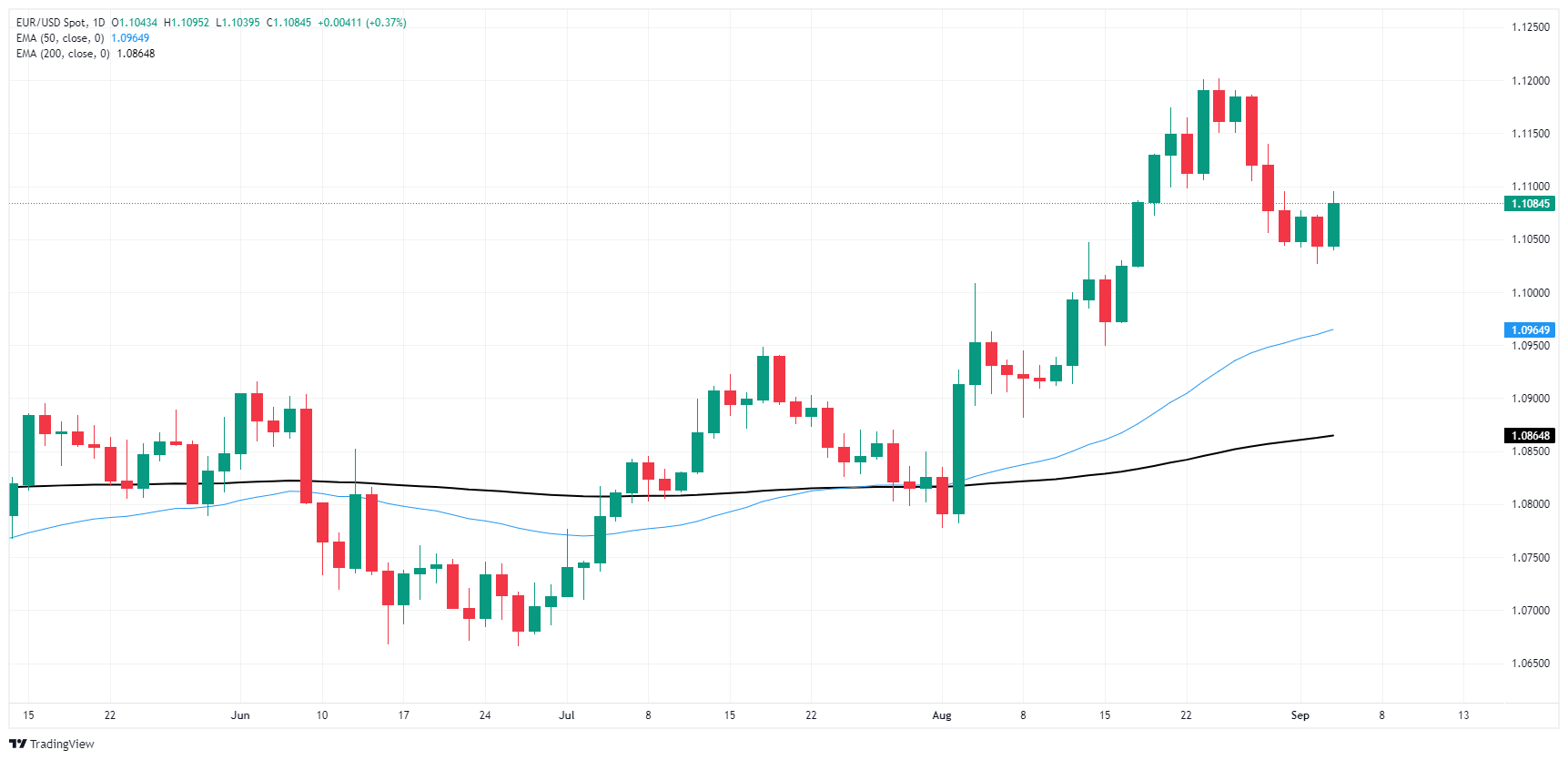EUR/USD catches a bullish break, but still trapped below 1.11
- EUR/USD rose on Wednesday as markets sell off Greenback.
- Markets have tilted into a risk-on position as bets of a Fed rate cut rise.
- US jobs data rules the market roost as investors look to NFP.
EUR/USD caught a bid on Wednesday, rebounding from a recent selloff and catching technical support from 1.1050. Despite the topside tilt to price action in the midweek, the pair remains hobbled below the 1.1100 handle. US jobs data will remain the key focus for markets this week in the run-up to Friday’s US Nonfarm Payrolls (NFP).
European Retail Sales remain the sole key data print from the EU side of the Pacific this week. Slated for early Thursday, pan-EU Retail Sales figures in July are expected to recover to a scant 0.1% YoY compared to the previous -0.3% contraction.
US JOLTS Job Openings in July missed the mark, adding 7.673 million available jobs compared to the forecast 8.1 million, compared to the previous month’s revised 7.91 million. With the Federal Reserve (Fed) broadly expected to begin cutting interest rates on September 18, markets are tilting further into bets of a 50 bps cut to kick off the next rate cutting cycle. Rate markets are still pricing in 100 bps in total cuts by the end of 2024, but there’s still a 57% chance of the Fed’s September rate call being a slimmer 25 bps, according to CME’s FedWatch Tool.
Friday's US Nonfarm Payrolls (NFP) report looms large and represents the last round of key US labor data before the Fed’s first rate trim. Friday's NFP print is widely expected to set the tone for market expectations regarding the depth of a Fed rate cut, with investors fully priced in on the start of a new rate-cutting cycle this month.
EUR/USD price forecast
Fiber has slumped back into near-term technical barriers, but bidders continue to come out of the woodwork to keep bids on balance even if they can’t quite pull out a bullish recovery. EUR/USD popped into a 13-month high just above 1.1200 early last week, and a near-term pullback in Greenback flows sees bids scrambling to hold onto bullish chart paper.
The pair still trades well north of the 200-day Exponential Moving Average (EMA) at 1.0845. Despite holding deep in the bull country, EUR/USD still faces a steepening bearish pullback as shorts congregate targets just above the 50-day EMA at 1.0956.
EUR/USD daily chart
Euro FAQs
The Euro is the currency for the 20 European Union countries that belong to the Eurozone. It is the second most heavily traded currency in the world behind the US Dollar. In 2022, it accounted for 31% of all foreign exchange transactions, with an average daily turnover of over $2.2 trillion a day. EUR/USD is the most heavily traded currency pair in the world, accounting for an estimated 30% off all transactions, followed by EUR/JPY (4%), EUR/GBP (3%) and EUR/AUD (2%).
The European Central Bank (ECB) in Frankfurt, Germany, is the reserve bank for the Eurozone. The ECB sets interest rates and manages monetary policy. The ECB’s primary mandate is to maintain price stability, which means either controlling inflation or stimulating growth. Its primary tool is the raising or lowering of interest rates. Relatively high interest rates – or the expectation of higher rates – will usually benefit the Euro and vice versa. The ECB Governing Council makes monetary policy decisions at meetings held eight times a year. Decisions are made by heads of the Eurozone national banks and six permanent members, including the President of the ECB, Christine Lagarde.
Eurozone inflation data, measured by the Harmonized Index of Consumer Prices (HICP), is an important econometric for the Euro. If inflation rises more than expected, especially if above the ECB’s 2% target, it obliges the ECB to raise interest rates to bring it back under control. Relatively high interest rates compared to its counterparts will usually benefit the Euro, as it makes the region more attractive as a place for global investors to park their money.
Data releases gauge the health of the economy and can impact on the Euro. Indicators such as GDP, Manufacturing and Services PMIs, employment, and consumer sentiment surveys can all influence the direction of the single currency. A strong economy is good for the Euro. Not only does it attract more foreign investment but it may encourage the ECB to put up interest rates, which will directly strengthen the Euro. Otherwise, if economic data is weak, the Euro is likely to fall. Economic data for the four largest economies in the euro area (Germany, France, Italy and Spain) are especially significant, as they account for 75% of the Eurozone’s economy.
Another significant data release for the Euro is the Trade Balance. This indicator measures the difference between what a country earns from its exports and what it spends on imports over a given period. If a country produces highly sought after exports then its currency will gain in value purely from the extra demand created from foreign buyers seeking to purchase these goods. Therefore, a positive net Trade Balance strengthens a currency and vice versa for a negative balance.